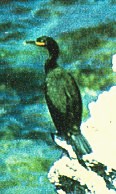 Synonyms: Phalacrocorax
albus Tray
Synonyms: Phalacrocorax
albus TrayPhalacrocorax aristotelis Linnaeus, 1761
 Synonyms: Phalacrocorax
albus Tray
Synonyms: Phalacrocorax
albus Tray
Common names: Bulg: Sreden cormaran; Engl: Shag; Rom: Cormaran motat; Russ: Khokhlaty baklan; Turk: Tepeli karabatak; Ukr: Baklan dovgonosy
Order: PELECANIFORMES
Family: PHALACROCORACIDAE
Taxonomic descriptions: Around 650-750 pairs.
 IUCN Status:
IUCN Status:
World level: EN
Black Sea Regional level: EN
Subregion level: EN
Distribution:
Habitats type, Critical habitats, Limiting factors: Breeds in small deepenings, niches, grottoes and cornices in the high sheer and rocky areas of the Crimean coast. Separate colonies are common, but sometimes mix with Cormorants, Yellow-legged Gulls and Rock Doves. The two kilometre water zone along the Black Sea coast is the principal feeding habitat. Small sea fish comprise its basic diet; copepods are also consumed. The major limiting factors are disturbance at the breeding sites, water pollution by oil products and solid domestic waste.
Biology: Breeding resident species. Arrival in the colony area depends on the weather and is prolonged from late February to early April. Breeding density and altitude (3-15 m) vary. Clutch size 2-3, infrequently 4 eggs. Egg-laying is prolonged up to more than 2 months. After the leaving of the nest birds occur in the surroundings of the colony. Second year birds, making in some areas up to 30-50% of the total numbers, keep to the colonies too. The best assimilated feeding habitat is the 200 metre strip of the sea along the shore-line. Gobies (Gobiidae) and scads (Carangidae) predominate in the diet.
Population trends: Population declines as well as the number of the colonies. Only 3 out of 15 known colonies have 35-40 pairs. The entire estimate for the rest is 8,020 pairs. The major stronghold is the Tarkhankut peninsula. There were 1,200 pairs in 1962. In 1973 the number decreased twice. A recent survey showed a further decline down to 400-450 pairs. The numbers of Shag are critical since the largest colonies are within the zone of considerable human influence, whereas smaller ones can not ensure the necessary reserve of the Black Sea population.
Threats: Growing human disturbance at the breeding sites, water pollution by oil products and solid waste disposal, decrease of the habitat feeding capacity, predation.
Conservation measures taken: One of the three main colonies is situated in a reserve.
Conservation measures proposed: Obligatory protection of all breeding colonies.
References:
Compiled by: V.Siokhin